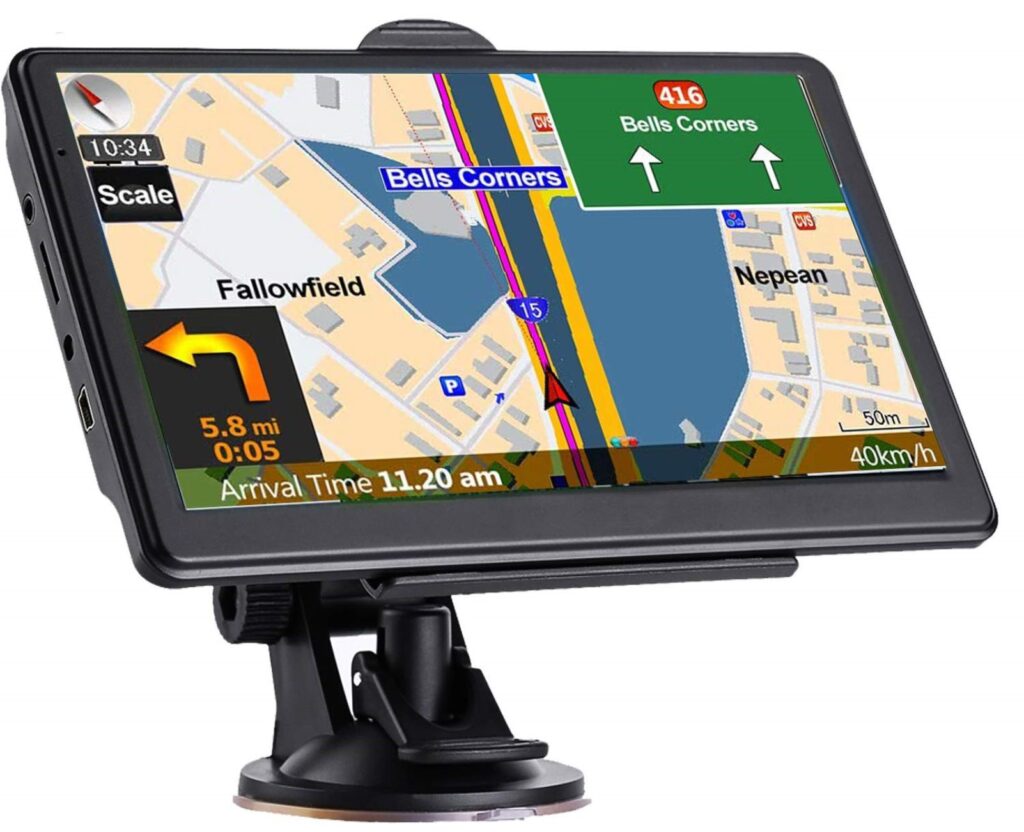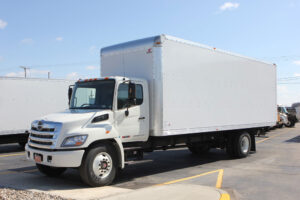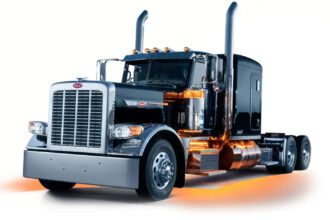Table of Contents
Ready to take your trailer truck business to the next level? Well, you’re in luck! Here are some essential accessories you need to succeed on the road. From GPS navigation systems that ensure precision in location tracking to dash cams that provide indisputable evidence in cases of accidents, these tools are your trusted companions. CB radio for real-time updates and camaraderie with fellow truckers, and the electronic logging device (ELD) to streamline operations and stay compliant with regulations.
Interesting, right? Read further.
1. GPS Navigation System

GPS navigation systems are vital accessories with diverse transportation, military, recreation, and science applications. Its accuracy, dependent on factors like satellite visibility and receiver quality, can pinpoint locations within 10 meters. This accessory is indispensable for accurate and reliable navigation, making it an essential choice for you if you are looking for precision in location, velocity, and time tracking across various fields.
- Customizes navigation based on your truck’s dimensions, weight, cargo type, and speed limits.
- Provides real-time information on traffic, weather, road closures, and other hazards.
- Delivers accurate and timely delivery information to your customers, including estimated time of arrival, current location, and delivery confirmation.
- Offers free map and route updates with Wi-Fi connectivity.
- Integrates seamlessly with eLogs and ELDs.
- Provides evidence for your safe driving record, helping to prevent fraudulent claims and recover stolen vehicles.
- Has potential software glitches and sluggish performance.
- Experiences weak or unstable magnetic mounts.
- Has lower quality or less durable hardware sometimes.
- Segments:
- Space Segment: Has 24 satellites orbiting at 20,000 km altitude, broadcasting position and time.
- Control Segment: Includes ground stations to monitor satellites, provide commands, and ensure accuracy.
- User Segment: Uses receivers to calculate location, velocity, and time relying on the use of trilateration.
- Applications:
- Applies to transportation, military, recreation, and science
- Serves for vehicle navigation, military precision, hiking, and seismic monitoring
- Accuracy and Factors:
- Locates within 10 meters; augmentation can achieve less than 1 cm.
- Depends on satellites, receiver quality, atmospheric conditions, and interference for precision.
- Global Reach:
- Offers worldwide accessibility, compatibility, and consistency
- Supports international cooperation and emerging technologies.
- Security:
- Uses encryption and authentication to prevent misuse and signal manipulation.
- Mitigates signal jamming and spoofing risks.
- Economic Impact:
- Makes significant contributions to logistics, aviation, and agriculture.
- Enhances efficiency, reduces costs, and drives innovation.
- Integration and Privacy:
- Integrates with INS, smartphones, and wearables.
- Addresses privacy concerns with user control over data.
- Environmental Monitoring:
- Supports environmental research and disaster management.
- Monitors climate, wildlife, and Earth’s processes.
>>>MORE: Trucking Business For Beginners
2. Dash Cam

Dash Cam is a valuable accessory for your vehicle, offering numerous benefits. It records video and audio while you drive, providing evidence in accidents, disputes, or violations and protecting you from liability and fraud. In a concise summary, a dash cam enhances safety, offers peace of mind, and can be a vital tool in various driving scenarios, making it a worthwhile addition to any vehicle.
- Provides indisputable evidence of accidents, and captures vital proof of fault, incident details, and damages, safeguarding you from false claims and legal hassles.
- Enhances safety when you review footage so you can identify and rectify risky behaviors, ensuring safer driving.
- Deters theft, vandalism, and road rage incidents.
- Reduces insurance costs, helping you protect your drivers’ records and demonstrating a commitment to safety, potentially earning discounts.
- Raises privacy concerns
- Comes with a substantial initial cost
- Distracts drivers at times.
- Recording Functionality: Record video and audio of your driving, providing evidence for accidents, disputes, and violations.
- Power Source: Power it up using as little as a cigarette lighter cable. It starts recording automatically with the ignition key.
- Continuous Loop Recording: Records in short 3-minute segments onto a microSD card, ensuring continuous coverage.
- Dash Cam Types:
- Single-lens Dash Cam: Captures only the front view, offering a simple and cost-effective option.
- Dual-lens Dash Cam: Records both front and rear views, providing enhanced coverage and security.
- Cabin-view Dash Cam: Views both the road and inside the vehicle, ideal for taxi or ride-share drivers.
- Resolution: Comes in different resolutions, including 1080p Full HD, 4K Ultra HD, or even 8K, for clear and detailed video.
- Night Vision: Some dash cams offer night vision capabilities, enhancing recording quality in low-light conditions.
- GPS Functionality: Dash cams with GPS record location, speed, and direction, aiding incident verification and driving habit tracking.
- Wi-Fi Connectivity: Wi-Fi enables dash cams to connect to smartphones or tablets, allowing for video viewing, sharing, and adjustments via an app.
- Parking Mode: Parking mode lets dash cams record when your vehicle is not in motion and off, capturing incidents like theft, vandalism, or hit-and-runs with motion detection or impact sensors.
- Enhanced Safety: Dash cams can help you monitor driving habits, improve safety, and deter theft, violence, or harassment.
- Legal Protection: Provides evidence for liability and fraud protection, ensuring you have the necessary documentation in case of disputes.
- Convenience: Wi-Fi and GPS features offer ease of use and seamless video management, while parking mode enhances security even when the vehicle is not in use.
3. CB Radio

A CB radio is a versatile communication tool that offers several key advantages. It provides reliable, accessible, and customizable communication solutions for various scenarios.
- Facilitates communication with fellow truckers for information sharing, advice, and camaraderie.
- Provides real-time alerts and updates on road conditions, enhancing route planning and safety.
- Operates without monthly fees or contracts, ensuring cost-effective communication in remote areas.
- Offers a limited communication range and is susceptible to interference.
- Requires adherence to specific etiquette rules.
- Represents outdated technology and may not align with modern preferences in the trucking industry.
- CB Radio Operation:
- Operates on 40 FCC-allocated channels.
- Uses a frequency range from 26.965 MHz to 27.405 MHz.
Requires no license for use.
CB Radio Features:
- Power Output: Max FCC-approved power: 4W (AM) and 12W (SSB).
- Squelch Control: Adjusts sensitivity to filter noise.
- Channel Selector: Accesses up to 40 channels; channel 9 is for emergencies.
- LCD Display: Shows channel, signal, battery, and more.
- ANL/NB Filter: Reduces noise and interference.
4. Trucker’s Logbook

Trucker’s logbook is an electronic logging device (ELD). Choosing an electronic logging device (ELD) for trucking is a wise decision due to its numerous advantages. ELDs automate the recording of crucial information, like hours of service (HOS), in compliance with Federal Motor Carrier Safety Administration (FMCSA) regulations. It saves time, reduces paperwork errors, enhances safety alerts to drivers of HOS limits, improves efficiency with data on driving habits and routes, and simplifies audits with accurate records.
- Ensures compliance with HOS rules, tracks driving time, and alerts drivers of limit violations.
- Enhances accuracy and efficiency through automated record-keeping, reducing errors and fines.
- Improves performance and profitability, and optimizes driving habits, routes, and customer satisfaction.
- Involves costs of installing ELD devices and purchasing accessories that can be expensive, and ongoing expenses like data plans or cloud storage may add to the financial burden.
- Raises privacy concerns as it constantly records and monitors your personal information, potentially making you uncomfortable about sharing details like location and driving habits with employers, customers, or authorities.
- Encounters technology issues such as glitches, malfunctions, or failures, compromising the reliability and security of your records and potentially causing disruptions in your daily operations.
- Trucker’s Logbook
- Is a legal requirement under FMCSA regulations
- Serves as a comprehensive document for recording crucial information about a trucker’s daily activities
- Includes hours of service, miles driven, fuel consumption, and more.
- Trucker’s Logbook Features:
- Involves a grid chart that consists of 15-minute increments, where truckers use four symbols:
- Vertical line for driving
- Horizontal line for on-duty not driving
- Diagonal line for sleeper berth
- Blank space for off-duty
- Includes personal details such as the trucker’s name, carrier, co-driver, date, vehicle number, and starting and ending locations in the header section.
- Contains a section for signatures to certify and ensure compliance at the end of each day.
- Involves a grid chart that consists of 15-minute increments, where truckers use four symbols:
- Hours of Service (HOS) Rules – Include regulatory guidelines that set limits on driving and working hours, as well as mandatory break and rest periods. Specific to whether truckers are transporting property or passengers, some key HOS rules include:
- Allows a maximum of 11 hours of driving after a minimum of 10 consecutive hours off duty.
- Permits a maximum of 14 hours on duty following a minimum of 10 consecutive hours off duty.
- Allows you to drive a maximum of 60 hours within 7 consecutive days, or 70 hours within 8 consecutive days.
- Affords you a 30-minute break, which is mandatory after 8 hours of driving or on-duty time
- Enables you as a trucker to split your 10-hour off-duty period into two segments, with one lasting at least 2 hours and the other at least 8 hours.
>>>PRO TIPS: 18-Wheeler Business Accessories you Need to Succeed
What To Watch Out For

- Cost and Value: Compare pricing, fees, and the value you receive.
- Load Volume and Diversity: Look for a wide range of daily loads.
- Data-Driven Insights: Seek tools for informed decision-making.
- User-Friendly Interface: Ensure ease of use.
- Mobile Accessibility: Use a mobile app or mobile-friendly website for on-the-go access
- Customer Service: Opt for responsive support. This is crucial
- Reviews and Reputation: Check user feedback.
- Technical Stability: Avoid platforms with frequent glitches.
- Integration Options: Confirm compatibility with your existing tools
- Free Trials: Test before committing.
- Scalability: Choose a platform that can grow with your business.
- Hidden Costs: Scrutinize pricing for hidden fees.
- Load Board Network: Choose a wider network for increased load visibility.
- Blockchain Features: Understand and leverage blockchain payment gateways if applicable.
- Unique Features: Identify any competitive advantages.
- Monthly Commitments: Ensure that flexibility aligns with your budget.
Recap
To succeed in the trailer truck business, you need essential accessories. Get a GPS navigation system to ensure accurate location tracking and real-time updates. Next, install a dash cam to enhance safety and protect yourself with indisputable video evidence. Equip your truck with a CB radio for reliable communication with fellow truckers and real-time road updates. Lastly, grab a trucker’s logbook to simplify compliance with regulations and optimize your operations.



















